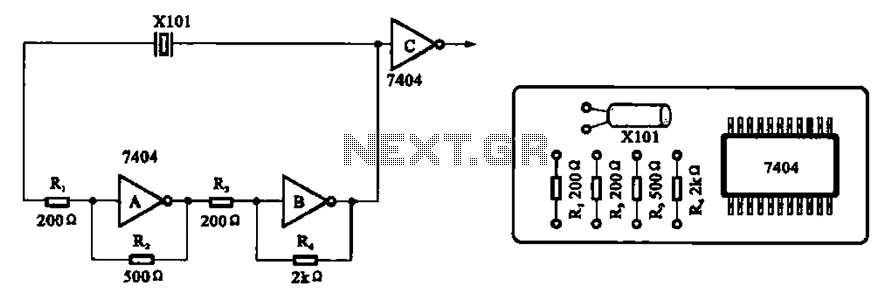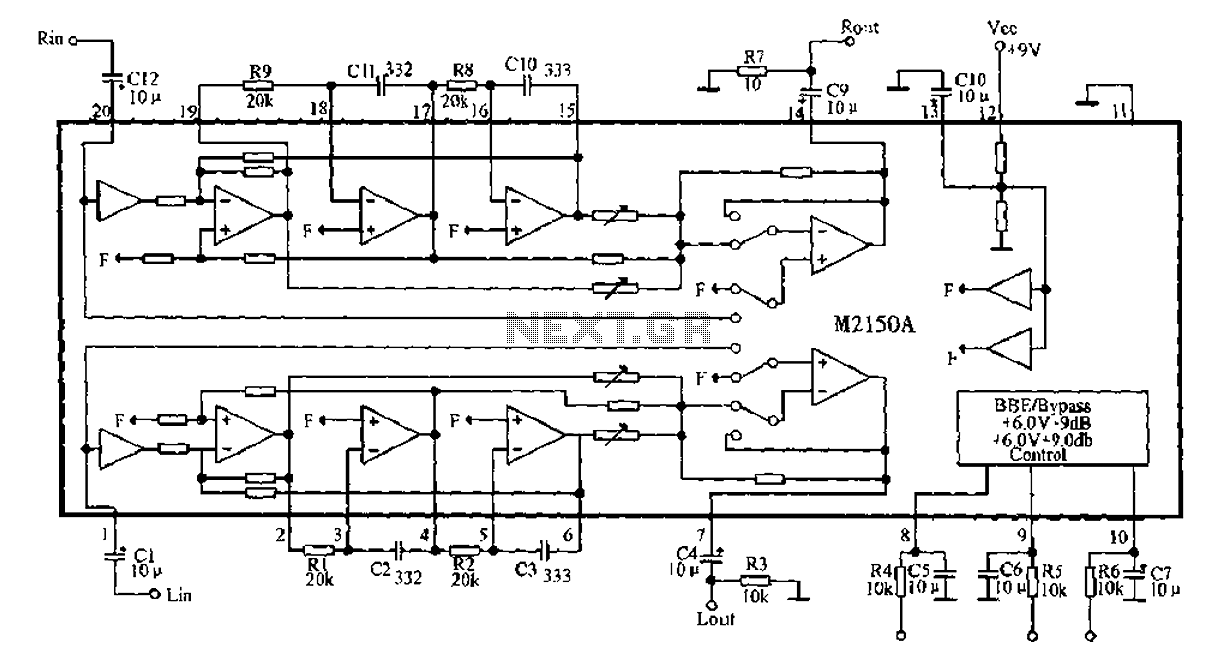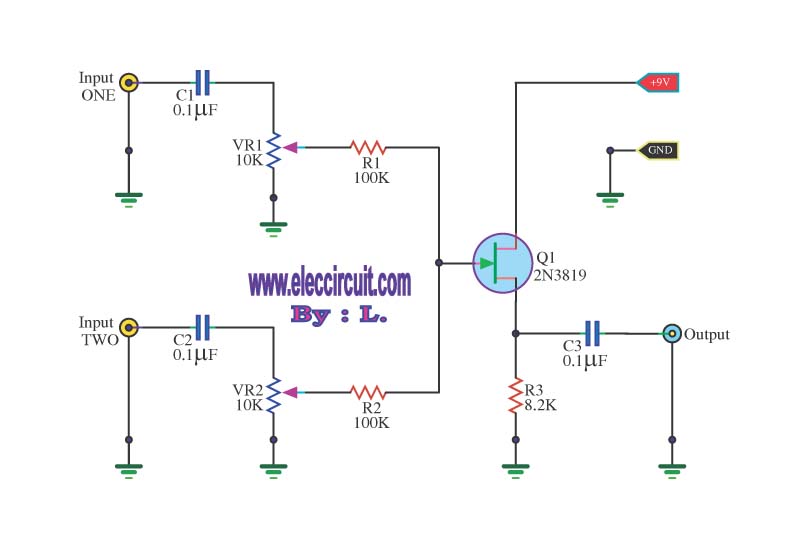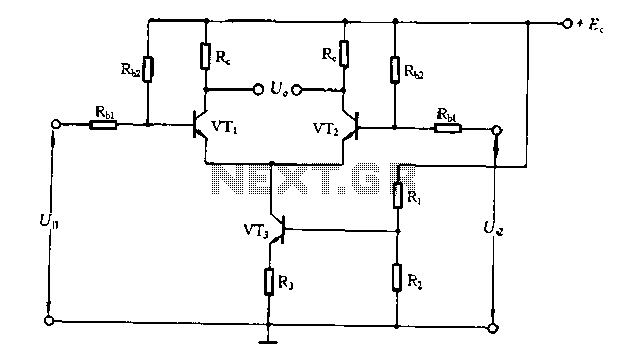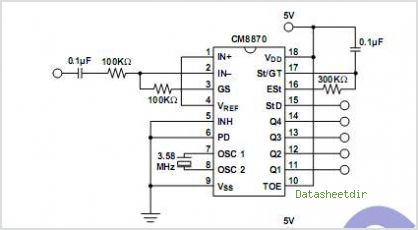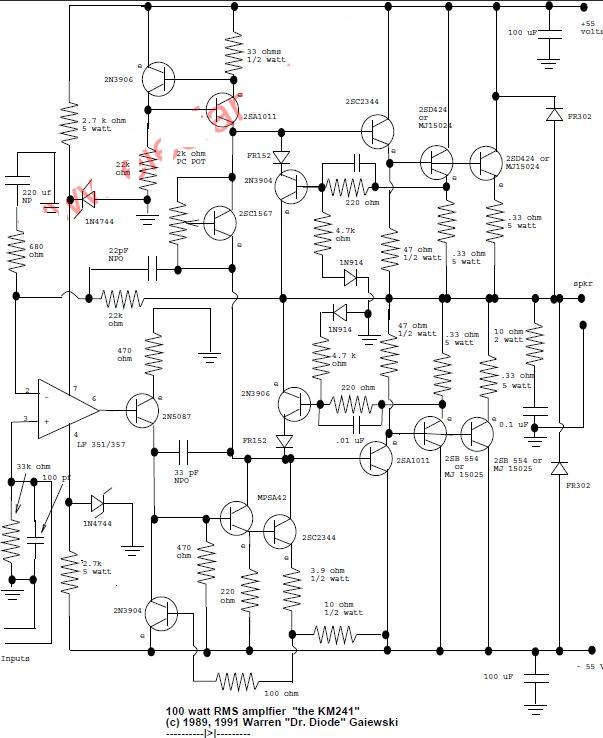
dtmf circuit
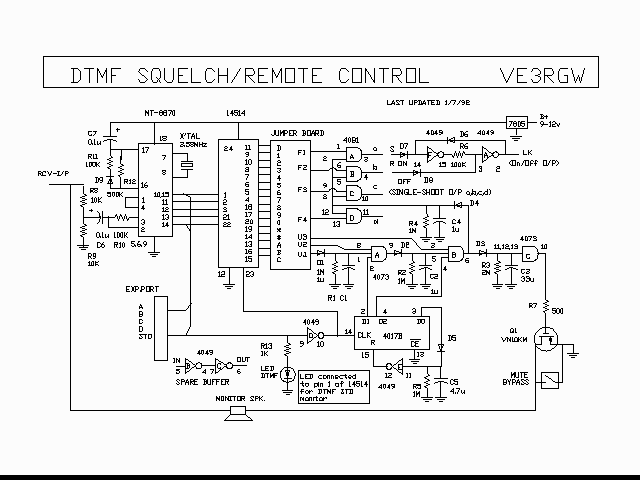
This article explains how to construct a general-purpose DTMF decoder using an affordable chip from MITEL. The circuit supports DTMF squelch based on a three-digit station ID (covering all 999 combinations). It can also decode four additional commands, which include the station ID and one extra digit, enabling remote control of external devices (such as on/off or single-shot trigger operations). An expansion port is included for future development. The core component of the system is the MT8870 DTMF decoder, a state-of-the-art single-chip DTMF receiver that utilizes "switched capacitor filter" technology and an advanced digital counting/averaging algorithm for period measurement. Traditional frequency decoding methods typically rely on frequency counting or phase-locking techniques, which can be time-consuming and inaccurate when processing unstable complex signals. In contrast, switched capacitor filter technology operates on the principle that alternating current (AC) signals represent rapid changes in potential energy over specific time intervals. AC components with the same frequency characteristics will exhibit identical timing in their instantaneous potential variations. For instance, a 1 Hz signal will reach its peak positive value every second, maintaining a constant duration of one second across any AC signal with a frequency of 1 Hz, regardless of waveform differences. A circuit designed to sample the potential value of a signal at predetermined intervals (for example, at exactly 90-degree phase shifts for a specific frequency) can identify the presence of an AC component at that frequency if the total sum of all samples consistently equals zero. Each fixed timing is effective for only one frequency. Given that DTMF consists of a combination of four row tones and four column tones, at least eight sets of such timing circuits are required. In practice, more than eight circuits are necessary to accommodate variations in the incoming DTMF signal, while the decoding results are derived from averaging the outputs of all filters. TWIST refers to the failure to decode a valid DTMF signal due to the non-linear frequency response of the transmission medium. Among the two challenges, TWIST is more manageable as it can be mitigated through audio equalization across the entire transmission path. This equalization can be implemented either internally within the DTMF decoding chip or externally via additional audio filters. According to factory specifications, the MT8870 can tolerate TWIST variations of +/- 6 dB, which is generally sufficient to compensate for pre-emphasis and de-emphasis distortions caused by FM media. TALKOFF, on the other hand, involves the erroneous recognition of DTMF components in human voice as genuine DTMF signals. This issue is unavoidable since human voices often contain valid DTMF combinations. Fortunately, the presence of these DTMF components in human voices is inconsistent. Unlike true DTMF generated from a touch-tone keypad, these "human" DTMF signals cannot maintain a constant combination. Therefore, they can be distinguished through DELAY discrimination. If a decoded DTMF signal persists for a duration exceeding typical human voice periods, it can be identified as a legitimate DTMF command. The schematic circuit includes several external components connected to the MT8870 (C2, R11, R12, D9). Pin 16 of the MT8870 is the EST (Early Steering) output, which indicates a logic high whenever a DTMF combination is detected in the input signal (including TALKOFF error detection). Pin 17 serves as the GT (guard time) control, functioning as a trigger-type input. The voltage level at pin 17 is established as a delayed EST through C7 and R12. If the DTMF detection persists long enough for the voltage at pin 17 to build up over time, it can be recognized as a valid DTMF signal. The STD output line is located at pin 10.
The DTMF decoder circuit primarily utilizes the MT8870 chip, which plays a crucial role in decoding the dual-tone multi-frequency signals. The design includes an input stage where the incoming audio signals are filtered and amplified to ensure they meet the required signal levels for the decoder. The switched capacitor filter technology employed in the MT8870 allows for precise frequency selection, enabling the decoder to differentiate between the various DTMF tones effectively.
The external components, such as capacitors and resistors, are selected to set the timing and filtering characteristics of the circuit, ensuring optimal performance under various signal conditions. For instance, the values of C2, R11, and R12 are critical in determining the response time and stability of the DTMF detection. The addition of the expansion port facilitates future enhancements to the circuit, allowing for integration with other systems or the addition of new features as technology evolves.
In terms of layout, the circuit should be designed to minimize noise and interference, which can adversely affect DTMF detection accuracy. Proper grounding techniques and the use of shielded cables for the input signal can help mitigate these issues. Furthermore, the implementation of audio equalization techniques can enhance the decoder's ability to handle TWIST and TALKOFF, ensuring reliable operation even in less-than-ideal conditions.
Overall, this DTMF decoder circuit offers a versatile solution for applications requiring remote control capabilities, leveraging the advanced features of the MT8870 chip to achieve reliable signal decoding and command execution.This article describes how to build a general purpose DTMF decoder with a low-price chip from MITEL. The circuit supports DTMF squelch based on 3 digits station ID (full 999 combination). It also supports decoding of 4 additional commands - station ID plus one more digit which can be used to perform remote control on external devices (on/off or si ngle shoot trigger operation ). One expansion port is included to provide future development. Core of the whole equipment is the MT8870 DTMF decoder. This is a state of art single chip DTMF receiver incorporating "switched capacitor filter" technology and advanced digital counting / averaging algorithm for period measurement. Conventional method of frequency decoding usually based on frequency counting or phase locking technique.
These methods are time consuming and inaccurate when handling unsteady complex signal. Switched capacitor filter technology based on a completely different approach. It works on the theory that any A. C. signal are rapid changes of potential energy with repect to specific time factor. A. C. components, provided that they bear the same frequency characteristic, will have the same timing on instantaneous potential variation. For example, a signal of frequency 1 Hz will experience peak positive value every one second. - the duration of 1 sec. will be constant among any A. C. signal bearing frequency 1 Hz, even though they have different wave forms. Suppose a circuit is designed to sample the potential value of a signal at preset intervals ( say, at exactly 90 degree phase shift timing for a specific frequency ).
If the total sum of all samples always experience zero while signal really present. We can conclude that an A. C. component of that specific frequency has been identified. Each fixed timing will be good for only one frequency. Since DTMF is a combination of 4 row tones and 4 column tones, it will need at least 8 sets of such time switching circuits. In the real world, there are more then 8 sets of such circuits in order to handle tolerance in the incoming DTMF signal while decoding result is developed on an averaging of outputs from all these filters.
TWIST is the failure of decoding a valid DTMF signal due to non-linear frequency response of a transmission media. Among the two enemies, TWIST is easier to deal with since it can be controlled by audio equalization on the whole transmission path.
These equalization can be done internally inside the DTMF decoding chip or externally via additional audio filters. According to factory specification, MT8870 can stand TWIST tolerance of +/- 6db. That is quite sufficient to compensate pre-emphasize and de-emphasize distortion caused by FM media. This should not be a problem unless the transmission is highly distorted. TALKOFF is the wrong recognition of DTMF component in human voice as true DTMF signal. This is an unavoidable factor since human voice always contain valid DTMF combination. Fortunately, presence of these valid DTMF components are unsteady. Unlike real DTMF generated from a touch-tone keyboard, these `human` DTMF cannot maintain on a constant combination.
So they can be isolated by DELAY discrimination. If a decoded DTMF signal can stay on constantly for certain duration which exceed those normal period experienced in human voice, then it can be identified as a real DTMF command. By looking at the schematic circuit, there are some external components hooked to MT8870 ( C2, R11, R12, D9 ).
Pin 16 of MT8870 is EST (Early Steering) output. It will flag logic high whenever DTMF combination is detected in the input signal ( including TALKOFF error detection ). Pin 17 is GT (guard time) control, it is a trigger type input. The level on pin 17 is arranged as a delayed EST via C7 and R12. If the detection of DTMF is long enough for voltage at pin 17 to build up with time, it can be considered as a valid DTMF signal.
The STD output line (pin 10) 🔗 External reference
The DTMF decoder circuit primarily utilizes the MT8870 chip, which plays a crucial role in decoding the dual-tone multi-frequency signals. The design includes an input stage where the incoming audio signals are filtered and amplified to ensure they meet the required signal levels for the decoder. The switched capacitor filter technology employed in the MT8870 allows for precise frequency selection, enabling the decoder to differentiate between the various DTMF tones effectively.
The external components, such as capacitors and resistors, are selected to set the timing and filtering characteristics of the circuit, ensuring optimal performance under various signal conditions. For instance, the values of C2, R11, and R12 are critical in determining the response time and stability of the DTMF detection. The addition of the expansion port facilitates future enhancements to the circuit, allowing for integration with other systems or the addition of new features as technology evolves.
In terms of layout, the circuit should be designed to minimize noise and interference, which can adversely affect DTMF detection accuracy. Proper grounding techniques and the use of shielded cables for the input signal can help mitigate these issues. Furthermore, the implementation of audio equalization techniques can enhance the decoder's ability to handle TWIST and TALKOFF, ensuring reliable operation even in less-than-ideal conditions.
Overall, this DTMF decoder circuit offers a versatile solution for applications requiring remote control capabilities, leveraging the advanced features of the MT8870 chip to achieve reliable signal decoding and command execution.This article describes how to build a general purpose DTMF decoder with a low-price chip from MITEL. The circuit supports DTMF squelch based on 3 digits station ID (full 999 combination). It also supports decoding of 4 additional commands - station ID plus one more digit which can be used to perform remote control on external devices (on/off or si ngle shoot trigger operation ). One expansion port is included to provide future development. Core of the whole equipment is the MT8870 DTMF decoder. This is a state of art single chip DTMF receiver incorporating "switched capacitor filter" technology and advanced digital counting / averaging algorithm for period measurement. Conventional method of frequency decoding usually based on frequency counting or phase locking technique.
These methods are time consuming and inaccurate when handling unsteady complex signal. Switched capacitor filter technology based on a completely different approach. It works on the theory that any A. C. signal are rapid changes of potential energy with repect to specific time factor. A. C. components, provided that they bear the same frequency characteristic, will have the same timing on instantaneous potential variation. For example, a signal of frequency 1 Hz will experience peak positive value every one second. - the duration of 1 sec. will be constant among any A. C. signal bearing frequency 1 Hz, even though they have different wave forms. Suppose a circuit is designed to sample the potential value of a signal at preset intervals ( say, at exactly 90 degree phase shift timing for a specific frequency ).
If the total sum of all samples always experience zero while signal really present. We can conclude that an A. C. component of that specific frequency has been identified. Each fixed timing will be good for only one frequency. Since DTMF is a combination of 4 row tones and 4 column tones, it will need at least 8 sets of such time switching circuits. In the real world, there are more then 8 sets of such circuits in order to handle tolerance in the incoming DTMF signal while decoding result is developed on an averaging of outputs from all these filters.
TWIST is the failure of decoding a valid DTMF signal due to non-linear frequency response of a transmission media. Among the two enemies, TWIST is easier to deal with since it can be controlled by audio equalization on the whole transmission path.
These equalization can be done internally inside the DTMF decoding chip or externally via additional audio filters. According to factory specification, MT8870 can stand TWIST tolerance of +/- 6db. That is quite sufficient to compensate pre-emphasize and de-emphasize distortion caused by FM media. This should not be a problem unless the transmission is highly distorted. TALKOFF is the wrong recognition of DTMF component in human voice as true DTMF signal. This is an unavoidable factor since human voice always contain valid DTMF combination. Fortunately, presence of these valid DTMF components are unsteady. Unlike real DTMF generated from a touch-tone keyboard, these `human` DTMF cannot maintain on a constant combination.
So they can be isolated by DELAY discrimination. If a decoded DTMF signal can stay on constantly for certain duration which exceed those normal period experienced in human voice, then it can be identified as a real DTMF command. By looking at the schematic circuit, there are some external components hooked to MT8870 ( C2, R11, R12, D9 ).
Pin 16 of MT8870 is EST (Early Steering) output. It will flag logic high whenever DTMF combination is detected in the input signal ( including TALKOFF error detection ). Pin 17 is GT (guard time) control, it is a trigger type input. The level on pin 17 is arranged as a delayed EST via C7 and R12. If the detection of DTMF is long enough for voltage at pin 17 to build up with time, it can be considered as a valid DTMF signal.
The STD output line (pin 10) 🔗 External reference
